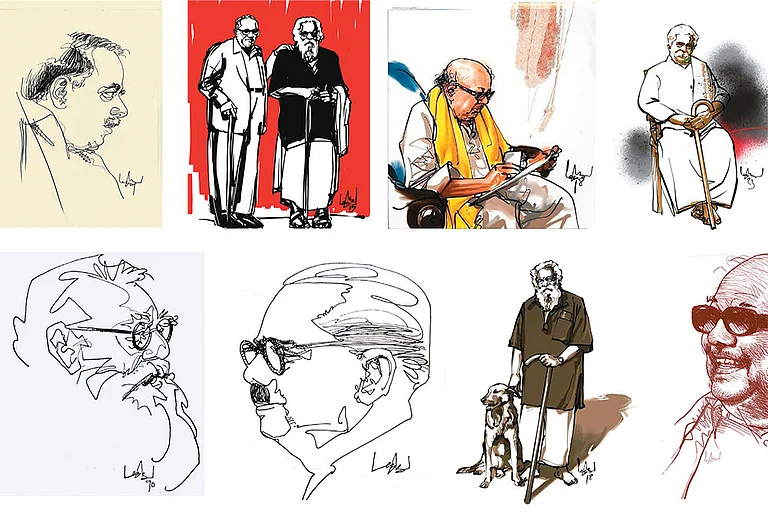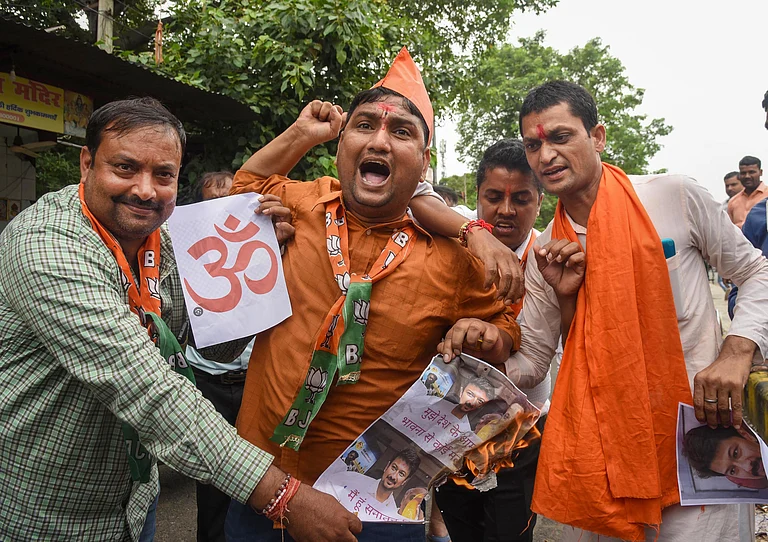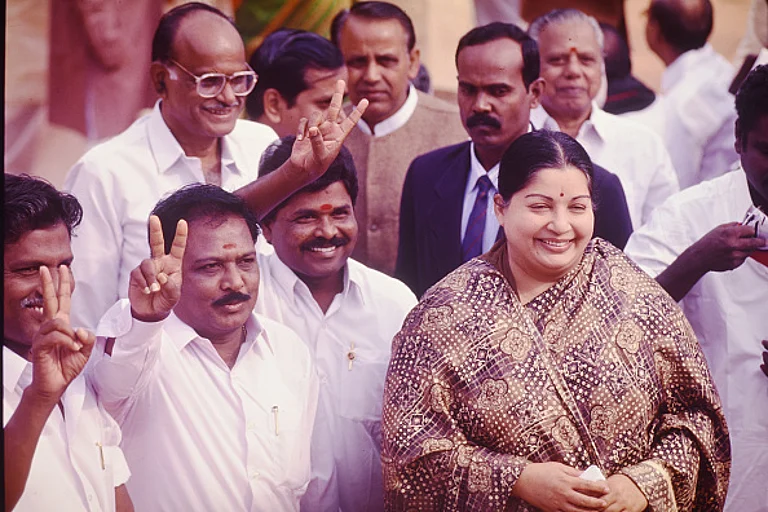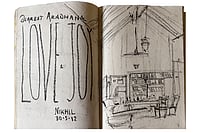At a crossroad, three statues draped in white, luminous against the black of the night, their hands raised as if to summon, are almost portentous. It is past midnight in Coimbatore. The eeriness of this encounter with the veiled figures reminds one of the three witches in Shakespeare’s Macbeth. The shapeshifters, the androgynous beings, the ones who are beyond definitions.
Coimbatore has turned into a battleground of ideologies. Conquest of power and hegemony, betrayal and rivalry between the political parties pitched against each other in a symbolic war. But there is another force. The memory of the riots in Coimbatore in 1998 is the leitmotif of the story in this prosperous south Indian district.
The past is what’s at stake here. The present oscillates between sovereignty and tyranny, the sacred and the evil. Between the past and the future.
It is a dark story. This is where it begins. At Avinashi Road. In front of the three statues.
“Fair is foul, and foul is fair”
—The three Weird Sisters in Macbeth
The statues are of the former Tamil Nadu Chief Minister and late All India Anna Dravida Munnetra Kazhagam (AIADMK) supremo J Jayalalithaa and M G Ramachandran that were installed alongside the C N Annadurai statue at the arterial Avinashi Road in Coimbatore.
***
“Let us listen to Stalin’s voice…
The language forcing people would be torn apart by
Stalin’s voice,
The Breakfast Scheme has brought Stalin’s voice in the hearts
of children,
The Rs 1,000 women’s scheme has brought Stalin’s voice in the hearts of women.”
—Stalin Kural, the DMK propaganda song for the 2024 general elections
On a stormy evening on April 12, the song plays in a loop at a public rally in Coimbatore where Tamil Nadu Chief Minister M K Stalin asked the Indian National Congress (INC) leader Rahul Gandhi to show a new dawn to the country. A giant stage, a replica of the facade of the old Parliament building with its massive pillars had been erected. Flags of the alliance partners fluttered in the wind. Everything was symbolic. A response and a resistance to the nationalist Hindutva ideology.

A new parliament building, inspired by the Vijaya temple in Vidisha in Madhya Pradesh, was inaugurated in May last year and the Sengol was established in it by Prime Minister Narendra Modi. The symbolism of this act wasn’t lost. On the night of August 14, 1947, Jawaharlal Nehru received the Sengol from the adheenams (priests) of the Thiruvaduthurai Adheenam (Mutt) in Tamil Nadu. It was the moment of transference of power by the British into Indian hands. There is a power struggle between the north and the south. Tamil Nadu, a bastion of Dravidian political ideology, has always been a difficult terrain for the Bharatiya Janata Party (BJP).
In 2014, after assuming office as prime minister, Narendra Modi chose Coimbatore for his first rally in Tamil Nadu.
Coimbatore is now the battleground for the Dravidian political ideology that bases its agenda on social justice, federalism and non-Brahminism; and Hindutva, which believes in Hindu supremacy. In Coimbatore, the Dravida Munnetra Kazhagam (DMK) has returned after 10 years to the Lok Sabha seat pitching the former mayor “Ganapathi” P Rajkumar against Singai G Ramachandran of the AIADMK and K Annamalai of the BJP.
On March 18, during his roadshow in Coimbatore, Modi paid homage to the 58 victims of the bomb blasts that happened 26 years ago. In a makeshift memorial, the photos of the dead had been installed at R S Puram, one of the 11 sites where bombs had exploded on February 14, 1998. The division bells have struck their note.
Coimbatore’s landscape is known for its textile industry, steel and aluminium foundries, gold and diamond jewellery, educational institutions and information technology. While promises of further development have been made by all parties, there is another side to the region. A history of communal violence. That’s why this is the portal. That’s why the stakes are high here.
***
On the wall of a small law chamber at Gopalapuram in Coimbatore, there is a stencil art of Lady Justice Goddess. The three symbols of justice: The Sword, The Balance and The Blindfold.
Has justice been served?
A K Kareem, the man in the chamber, a writer and a lawyer, says maybe it won’t come to that. That’s the sad part. But there’s memory and that will always stand in the way of history. Like Kashmiri poet Agha Shahid Ali wrote, “Your history gets in the way of my memory. I am everything you lost.”
There is a power struggle between the north and the south. Tamil Nadu, a bastion of Dravidian political ideology, has always been a difficult terrain for the Bharatiya Janata Party (BJP).
Kareem points to a poster in another room. A huge lock on a door, a shadow engulfing it all, hands emerging from the shadow and gripping the house. Drawn by a schoolteacher named Tamil Pithan, the image was the cover of the first edition of Kareem’s Thalidappatta Kathavugal (bolted doors). This 2016 book is a compilation of stories of those who suffered in the blasts and the communal violence in 1997 and 1998 in Coimbatore. That’s Kareem’s resistance. Truth and history and memory are not always the same things.
What happened then is what people want to move beyond here. But under the city’s seemingly modern veneer, there is the darkness that spills over. Sometimes, the past can open a portal. Coimbatore is now that portal through which the ruling BJP, the Hindu nationalist party, is trying to enter Tamil Nadu, which has long been the stronghold of Dravidian politics that centres around social justice.
Kareem remembers the evening in 1997 when the mob rushed to the shrine where his family had gathered after his grandmother’s death. The men started throwing children over the wall on to the other side. That’s how they saved them. The women inside the shrine hid the other two men. Kareem witnessed it all. The desperation and the fear.
On November 29, 1997, traffic constable Anthony Selvaraj was stabbed to death by eight unknown assailants at Big Bazaar Street. The killers were identified as Muslims who were affiliated with the Al-Ummah, a Muslim group. The police staged a dharna. Riots ensued. Twenty-four people were killed. “The men in the community made the accused surrender,” Kareem says. “But people still died. Both Hindus and Muslims.”
Shafi, Ashiq, Abbas and Abudhahir were sentenced ”to be hanged till their last breath‘ by a fast-track court in 2002.
Three months later, in February, serials blasts rocked the city.
In another Muslim neighbourhood at around the same time, a man stepped out of his house and put a heavy lock on the door. He climbed up a ladder and entered the house through the roof. He and his family stayed put in the house while the killers went on a rampage outside. There was a moringa tree inside the premises and the family of four ate the leaves to survive. That’s the first story in Kareem’s book. The story of the lock and complete helplessness.
Years later, he went around looking for stories of people who survived during the violence and the riots of 1997 and 1998.
He remembers the check posts. The police would even split open an idli or tear up a roti out of suspicion in Muslim-dominated areas like Ukkadam, Kottaimedu and Karumbukadai in Coimbatore. It was 1998, the year when 58 people were killed and hundreds were injured in the serial blasts that happened right before former BJP leader L K Advani was to address a rally there at 4 pm. Ignoring security warnings, he had gone to visit the victims. Between then and 2017, the architect of the Rath Yatra that led to the demolition of the Babri Masjid in 1992, visited Coimbatore five times. Each time, he talked about the blasts.
The BJP’s candidate in alliance with the AIADMK, C P Radhakrishnan, won in 1998 and 1999 in the aftermath of the bombings. In 2014, he was selected as the BJP candidate for the Lok Sabha seat again from the Coimbatore constituency.
The check posts still exist.
It hasn’t been the same since. G Balakrishnan (44), who is in the jewellery business, was in his 20s when the blasts happened. He lived in Sullivan Street, which is half a kilometre away from Raja Street where a bomb exploded. His neighbour was injured. “I was shattered,” he says. “There was no problem with the Hindus and the Muslims before. Four of my best friends were Muslims,” he adds.
One of them, a man called Abdul, owned Best Bakery near the bus stand. They would have tea there. A cylinder was thrown by a Hindu mob and the shop was blown away.What remains are flashes of memories. Areas in the city began to be labelled as Hindu or Muslim. “Segregation was what the blasts gave us,” Balakrishnan says. According to him, the seeds of suspicion were sown then.
An AIADMK worker says that the party didn’t have the foresight to think it would be used during elections decades later. A tragedy fulfils its destiny in its recurrence.
In 2023, Annamalai targeted the DMK government over the issue of the release of the convicts of the 1998 serial blasts. He accused the ruling party of “minority appeasement” and in February, he said that the safety of Coimbatore is paramount. While he didn’t name any party then, he said those who were in power all these years in the state had failed to curb terrorism.
He pointed out that under Modi, the country has adopted a strategy of “offensive defense” and that this model should be implemented in Tamil Nadu. The area has seen a litany of blasts over the years. The BJP state president, who has adopted the same offensive defense strategy in his campaign against the other parties, also said a memorial stupa for the victims would be built if he wins the elections. He even promised a second National Investigation Agency (NIA) police station in Tamil Nadu to combat terrorism.
A Gounder by caste, he calls himself the son of the soil. But he is from Karur, the other candidates say.
“What does he know about Coimbatore? The fight is between the DMK and the AIADMK,” says Rajkumar.
***
At a makeshift office within a huge tent, G K Nagaraj, state president of the Kisan Morcha of the BJP, declares it is time for a change. “What Dravidian politics did was divide and rule like the British,” he says. “Periyar and others who promoted social justice and self-respect came from Andhra Pradesh, Kerala and Karnataka. Now, the Tamil people must take over. The Gujarat-model government is needed here.”
In 2017, Nagaraj, the president of Kongu Nadu Jananayaka Katchi (KJK) joined the BJP, marking the formal merger of his party with the latter.
Inside the office, a large eagle in bronze sits on his table. A predator. An ambitious species.
***
Elsewhere in the city, a group of men and women carries the BJP flags and beats drums saying Annamalai is the man of the moment.
A young man sports a T-shirt with Modi’s sketch on it. Orange coloured.
Another man named Jeeva thinks Coimbatore needs new energy. “He is close to the prime minister. It will help this region get better schemes,” he says.
The past is what’s at stake here. The present oscillates between sovereignty and tyranny, the sacred and the evil.
But between the projection and the reality, a lot is lost in translation. Especially for the media that had descended upon the district like hawks looking for a kill. A story that is sensational. A story that has conflict. A story that mutates into propaganda.
Annamalai has become their main protagonist. But the plot doesn’t favour the hero. It is the place that’s the protagonist. It is the contradictions in the region that feed into the plot. Too many and too full of complexities. Caste and faith. Money and rights. They intertwine.
Now, the BJP is trying to consolidate different caste groups by aligning with parties like the Kongu Nadu Munnetra Kazhagam (KMK), Nadar Makkal Munnetra Sangam (NMMS), Tamil Nadu Brahmins’ Association and Tamil Nadu Thevar Munnani.
The Hindu Makkal Katchi (HMK) founder and president Arjun Sampath who was a Rashtriya Swayamsevak Sangh (RSS) pracharak in the 1980s and was allegedly involved in the 1997 attacks, says the time has come for the Tamil people to reclaim their identity. He has been detained several times over the last few years for his controversial statements and activities. Sampath was born in Coimbatore and became a member of the RSS in his teenage years. At his house, not very far from a site of the bomb blast in 1998, he greeted two priests on the morning on April 16. According to him, the ruling DMK is trying to demolish temples across the state, which is deeply religious, claiming that the tribals were also Sanatanis and their gods are Hindu deities.
“Their ways of worship are different. Muslims and Christians are all part of the Sanatana Dharma,” Sampath says. “Coimbatore is a totally Hindu place,” he adds. “We are with the BJP.”
Sampath points out that the DMK is always speaking against Sanatana Dharma. “Our Tamil people are not Dravidians,” he says. “Dravidian culture is anti-god. ‘Dravid’ means Brahmin. Religion and nationalism are not different.”
In another corner of the district, a group of indigenous people had gathered at a hall waiting for Annamalai. It was April 15. He didn’t show up.
The Badagas, who belong to the Nilgiris, Erode and parts of Coimbatore, are supporting Annamalai in the hope that the tribal community will finally be included in the Scheduled Tribes (ST) list. At present, the Badagas are categorised as ‘‘Backward Class’’ in Tamil Nadu through constitutional orders.
The Nilgiri Tribal Solidarity (TNTS), an association of the Badaga tribe, says they have around two lakh voters. “We have our gods. Hethei and Aiyya,” Rama Gawdar, an old office-bearer of the association, says. “Annamalai has said he will get us the ST status.”
Although the oneness of nation and language is not lost on them, hope is another story.
***
The blindfold of Lady Justice can be another kind of metaphor here. The sword, too.
The lawyer says it is all about interpretations now. That’s where the narrative lies. Not in truth but in assertions. In conjectures, not in memory. He says he will continue to write the stories. Of locked doors and other injustices.
MORE FROM THIS ISSUE
Chinki Sinha in Coimbatore
(This appeared in the print as 'Sengol, A Makeshift Memorial And The Bolted Door')

































